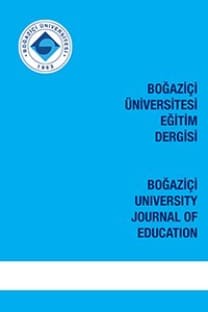Needs-Analysis: The First Step in Content Development for Mobile Learning
Needs-analysis, Mobile learning, Vocational language learning needs
___
- Atwell, J. (2005). A technology update and m-learning project summary. London: Learning and Skill Development Agency.
- Bayyurt, Y., & Tıkaç, S. (forthcoming). Mobile language learning (MLL) in vocational high schools. In P. Broeder & M.J.W. Stokmans (Eds.), Proceedings of the 6th GET-IN Conference. Tilburg: Tilburg University Publications.
- Bernard, H. (1988). Research methods in cultural anthropology. Newbury Park, CA: Sage.
- Brown, J. D. (2009). Foreign and second language needs analysis. In M. H. Long & C. J. Doughty (Eds.), The handbook of language teaching (pp. 269–293). Oxford: Blackwell.
- Chambers, F. (1980). A re-evaluation of needs analysis. ESP Journal, 1(1), 25–33.
- Dickinson, L. (1991). Self-Instruction in Language Learning. Cambridge: Cambridge University Press.
- Dudley-Evans, T., & St John, M. J. (1998). Developments in English for specific purposes. Cambridge: Cambridge University Press. Glesne, C., & Peshkin, A. (1992). Becoming qualitative researchers: An introduction. White Plains, NY: Longman.
- Graves, K. (1996). Teachers as course developers. England: Cambridge University Press.
- Hamp-Lyons. (2001). English for academic purposes. In R. Carter & D. Nunan (Eds.), The Cambridge guide to teaching English to speakers of other languages (pp. 126–130). Cambridge: Cambridge University Press.
- Hutchinson and Waters. (1987). English for specific purposes. New York: Cambridge University.
- Kavaliauskiene, G., & Uzpaliene, D. (2003). Ongoing needs analysis as a factor to successful language learning. Journal of Language and Learning, 1(1), 4–11.
- Kukulska-Hulme, A. (2006). Mobile language learning now and in the future. In P. Svensson (Ed.), Från vision till praktik: Språkutbildning och Informationsteknik (From vision to practice: Language learning and IT) (pp. 295–310). Sweden: Swedish Net University (Nätuniversitetet).
- Kukulska-Hulme, A., & Traxler, J. (2005). Mobile learning: A handbook for educators and trainers. London, UK: Routledge.
- Kukulska-Hulme, A., & Traxler, J. (2007). Designing for mobile and wireless learning. In H. Beetham & R. Sharpe (Eds.), Rethinking pedagogy for a digital age: Designing and delivering e-learning (pp. 180–192). London: Routledge.
- Kukulska-Hulme, A. & Pettit, J. (2009). Practitioners as innovators: Emergent practice in personal mobile teaching, learning, work and leisure. In M. Ally (Ed.), Mobile Learning: transforming the delivery of education and training. Issues in Distance Education (pp. 135–155). Athabasca: Athabasca University Press.
- Kukulska-Hulme, A. (2011, October). Lifelong language learning in a mobile age. Plenary speech presented at MLARG Final Conference, Istanbul, Turkey.
- Lett, J. A. (2005). Foreign language needs assessment in the US military. In M. H. Long (Eds.), Second language needs analysis (pp. 105–124). Cambridge: Cambridge University Press.
- Long, M. H. (2005), Second language needs analysis. Cambridge: Cambridge University Press.
- Munby, J. (1978). Communicative syllabus design. Cambridge: Cambridge University Press.
- Purpura, J. E., & Graziano-King, J. (2004). Investigating the foreign language needs of professional school students in international affairs: A case study. Working Papers in TESOL & Applied Linguistics, Teachers College, Columbia University, 4(1), 1–33. Retrieved from http://www.hawaii.edu/sls/uhwpesl/25(1)/Watanabe.pdf.
- Richards, J. (2001). Curriculum development in language teaching. Cambridge: Cambridge University Press.
- Robinson, P. (1991). ESP today: A practitioner’s guide. New York: Prentice Hall.
- Valk, J. H., Rashid, A. T. & Elder, L. (2010). Using mobile phones to improve educational outcomes: An analysis of evidence from Asia. The International Review of Research in Open and Distance Learning, 11(1), Retrieved from: http://www.irrodl.org/index.php/irrodl/article/view/794/1487.
- Van Avermaet, P., & Gysen, S. (2006). From needs to tasks: Language learning needs in a task-based approach. In K. Van den Branden (Eds.), Task-based language teaching in practice (pp. 17–46). Cambridge: Cambridge University Press.
- Wishart, J. (2011, October). Research into teacher trainees and the way they can use mobile phones to support them in their teaching and learning. Plenary speech presented at MLARG Final Conference, Istanbul, Turkey.
- ISSN: 1300-9567
- Yayın Aralığı: 3
- Başlangıç: 1976
- Yayıncı: Boğaziçi Üniversitesi
M-Learning System Implementation and Features
Jaromír HRAD, Tomáš ZEMAN, Marek NEVOSAD
Needs-Analysis: The First Step in Content Development for Mobile Learning
Yasemin BAYYURT, Nur Başak KARATAŞ
Subsystem for M/E-learning and Virtual Training based on IMS NGN Architecture
Pavol PODHRADSKÝ, Radovan KADLİC, Ondrej LÁBAJ, Juraj LONDÁK, Peter TRÚCHLY
Pedagogical Issues in Developing Mobile Assisted Language Learning Materials
Exploring the Major Determinants of Mobile Learning Adoption
